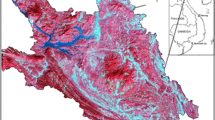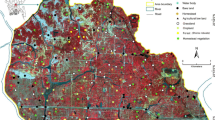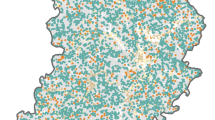Abstract
A stepwise masking system with high-resolution IKONOS imagery was developed to identify and map urban forest tree species/groups in the City of Tampa, Florida, USA. The eight species/groups consist of sand live oak (Quercus geminata), laurel oak (Quercus laurifolia), live oak (Quercus virginiana), magnolia (Magnolia grandiflora), pine (species group), palm (species group), camphor (Cinnamomum camphora), and red maple (Acer rubrum). The system was implemented with soil-adjusted vegetation index (SAVI) threshold, textural information after running a low-pass filter, and brightness threshold of NIR band to separate tree canopies from non-vegetated areas from other vegetation types (e.g., grass/lawn) and to separate the tree canopies into sunlit and shadow areas. A maximum likelihood classifier was used to identify and map forest type and species. After IKONOS imagery was preprocessed, a total of nine spectral features were generated, including four spectral bands, three hue–intensity–saturation indices, one SAVI, and one texture image. The identified and mapped results were examined with independent ground survey data. The experimental results indicate that when classifying all the eight tree species/ groups with the high-resolution IKONOS image data, the identifying accuracy was very low and could not satisfy a practical application level, and when merging the eight species/groups into four major species/groups, the average accuracy is still low (average accuracy = 73%, overall accuracy = 86%, and κ = 0.76 with sunlit test samples). Such a low accuracy of identifying and mapping the urban tree species/groups is attributable to low spatial resolution IKONOS image data relative to tree crown size, to complex and variable background spectrum impact on crown spectra, and to shadow/shaded impact. The preliminary results imply that to improve the tree species identification accuracy and achieve a practical application level in urban area, multi-temporal (multi-seasonal) or hyperspectral data image data should be considered for use in the future.
Similar content being viewed by others
References
Andreu, M. G., Friedman, M. H., Landry, S. M., & Northrop, R. J. (2008). City of Tampa urban ecological analysis 2006–2007. Final Report to the City of Tampa, 24 April 2008. City of Tampa, Florida.
Biging, G. S., Congalton, R. G., & Murphy, E. C. (1991). A comparison of photointerpretation and ground measurements of forest structure. In Proceedings of the 57th annual meeting of American society for photogrammetry and remote sensing (pp. 6–15). March 1991, Baltimore, MD. Bethesda, MD, USA: American Society for Photogrammetry and Remote Sensing.
Brockhaus, J. A., & Khorram, S. (1992). A comparison of SPOT and Landsat TM data for use in conducting inventories of forest resources. International Journal of Remote Sensing, 13, 3035–3043.
Carleer, A., & Wolff, E. (2004). Exploitation of very high resolution satellite data for tree species identification. Photogrammetric Engineering and Remote Sensing, 70(1), 135–140.
Carreiras, J. M. B., Pereira, J. M. C., & Pereira, J. S. (2006). Estimation of tree canopy cover in evergreen oak woodlands using remote sensing. Forest Ecology and Management, 223(1–3), 45–53.
Clark, M. L., Roberts, D. A., & Clark, D. B. (2005). Hyperspectral discrimination of tropical rain forest tree species at leaf to crown scales. Remote Sensing of Environment, 96, 375–398.
Congalton, R. G., & Mead, R. A. (1983). A quantitative method to test for consistency and correctness in photointerpretation. Photogrammetric Engineering and Remote Sensing, 49(1), 69–74.
Congalton, R., Miguel-Ayanz, J., & Gallup, B. (1991). Remote sensing techniques for hardwood mapping. Contract Report to California Dept. of Forestry and Fire Protection, Sacramento, California.
Curran, P. J. (1989). Remote sensing of foliar chemistry. Remote Sensing of Environment, 30, 271–278.
Davis, F. W., Brown, R. W., Buyan, B., & Kealy, J. (1995). Vegetation change in blue oak and blue oak/foothill pine woodland. Contract Report of Forest and Rangeland Resources Assessment Program, California Department of Forestry and Fire Protection, Sacramento, California.
Davis, C. H., & Wang, X. (2003). Planimetric accuracy of Ikonos 1 m panchromatic orthoimage products and their utility for local government GIS basemap applications. International Journal of Remote Sensing, 24(22), 4267–4288.
Dwyer, J. F., McPherson, E. G., Schroeder, H. W., & Rowntree, R. A. (1992). Assessing the benefits and costs of the urban forest. Journal of Arboriculture, 18, 227–234.
Franklin, S. E. (1994). Discrimination of subalpine forest species and canopy density using digital CASI, SPOT, and Landsat TM data. Photogrammetric Engineering and Remote Sensing, 60, 1233–1241.
Fung, T., Ma, F. Y., & Siu, W. L. (1998). Hyperspectral data analysis for subtropical tree species recognition. In Symposium proceedings, IGARSS’98, sensing and managing the environment (Vol. 3, pp. 1298–1300). New York, NY, USA: IEEE International Geoscience and Remote Sensing, Seattle, WA, USA, 6–10 July 1998.
Gong, P., & Chen, J. (1992). Boundary uncertainties in digitized maps I: Some possible determination methods. In Proceedings of the 1992 geographic information system & land information system (pp. 274–281). San Jose, California.
Gong, P., Pu, R., & Yu, B. (1997). Conifer species recognition: An exploratory analysis of in situ hyperspectral data. Remote Sensing of Environment, 62, 189–200.
Goodwin, N., Turner, R., & Merton, R. (2005). Classifying eucalyptus forests with high spatial and spectral resolution imagery: An investigation of individual species and vegetation communities. Australian Journal of Botany, 53, 337–345.
Hall, R. J., Franklin, S. E., Gerylo, G. R., & Roberts, A. (1998). Estimation of crown closure and species composition from high resolution multispectral imagery. In D. A. Hill & D. G. Leckie (Eds.), Automated interpretation of high spatial resolution digital imagery for forestry (pp. 309–320). Victoria, British Columbia, Canada, 10–12 February 1998. Natural Resources Canada, Canadian Forest Service, Pacific Forestry Centre, Victoria, British Columbia.
ITT (2006). ENVI version 4.3. Boulder, CO: ITT Industries, Inc.
Jain, S., & Jain, R. K. (2006). A remote sensing approach to establish relationships among different land covers at the micro level. International Journal of Remote Sensing, 27(13), 2667–2682.
Jensen, J. R. (2005). Introductory digital image processing: A remote sensing perspective (3rd ed., pp. 210–215). Prentice Hall: Upper Saddle River, NJ.
Jensen, J. R. (2007). Remote sensing of the environment: An earth resource perspective (2nd ed., pp. 444–450). Prentice Hall: Upper Saddle River, NJ.
Johansen, K., & Phinn, S. (2006). Mapping structural parameters and species composition of riparian vegetation using IKONOS and Landsat ETM plus data in Australian tropical savannahs. Photogrammetric Engineering and Remote Sensing, 72(1), 71–80.
Kosaka, N., Akiyama, T., Bien, T., & Kojima, T. (2005). Forest type classification using data fusion of multispectral and panchromatic high-resolution satellite imageries. In Geoscience and remote sensing symposium, 2005. IGARSS ‘05. Proceedings 2005 IEEE international (Vol. 4, pp. 2980–2983).
Nichol, J., & Wong, M. S. (2007). Remote sensing of urban vegetation life form by spectral mixture analysis of high-resolution IKONOS satellite images. International Journal of Remote Sensing, 28(5), 985–1000.
Pu, R. (2009). Broadleaf species recognition with in situ hyperspectral data. International Journal of Remote Sensing, 30(11), 2759–2779.
Pu, R., Gong, P., Michishita, R., & Sasagawa, T. (2006). Assessment of multi-resolution and multi-sensor data for urban surface temperature retrieval. Remote Sensing of Environment, 104, 211–225.
Pu, R., Kelly, M., Anderson, G. L., & Gong, P. (2008). Using CASI hyperspectral imagery to detect mortality and vegetation stress associated with a new hardwood forest disease. Photogrammetric Engineering and Remote Sensing, 74(1), 65–75.
Pu, P., Landry, S., & Yu, Q. (2010). Object-based urban detailed land cover classification with high spatial resolution IKONOS imagery. International Journal of Remote Sensing (in press).
Song, C. (2005). Spectral mixture analysis for subpixel vegetation fractions in the urban environment: How to incorporate endmember variability? Remote Sensing of Environment, 95, 248–263.
Story, M., & Congalton, R. G. (1986). Accuracy assessment: A user’s perspective. Photogrammetric. Engineering & Remote Sensing, 52(3), 397–399.
SWFWMD (2006). 2006 Natural color imagery for Hillsborough County. Southwest Florida Water Management District. Brooksville, FL. http://www.swfwmd.state.fl.us/data/gis/doqq_search.htm. Accessed 2 January 2007.
Townsend, P. A., & Walsh, S. J. (2001). Remote sensing of forested wetlands: Application of multitemporal and multispectral satellite imagery to determine plant community composition and structure in southeastern USA. Plant Ecology, 157, 129–149.
van Aardt, J. A. N., & Wynne, R. H. (2001). Spectral separability among six southern tree species. Photogrammetric Engineering and Remote Sensing, 67(12), 1367–1375.
Weng, Q., Lu, D., & Schubring, J. (2004). Estimation of land surface temperature-vegetation abundance relationship for urban heat island studies. Remote Sensing of Environment, 89, 467–483.
Wang, L., Sousa, W. P., & Gong, P. (2004a). Integration of object-based and pixel-based classification for mapping mangroves with IKONOS imagery. International Journal of Remote Sensing, 25(24), 5655–5668.
Wang, L., Sousa, W. P., Gong, P., & Biging, G. S. (2004b). Comparison of IKONOS and QuickBird images for mapping mangrove species on the Caribbean coast of Panama. Remote Sensing of Environment, 91(3–4), 432–440.
Xiao, Q. F., & McPherson, E. G. (2003). Rainfall interception by Santa Monica’s municipal urban forest. Urban Ecosystems, 6, 291–302.
Xiao, Q., Ustin, S. L., & McPherson, E. G. (2004). Using AVIRIS data and multiple-masking techniques to map urban forest tree species. International Journal of Remote Sensing, 25(24), 5637–5654.
Yang, L., Xian, G., Klaver, J. M., & Deal, B. (2003). Urban lad-cover change detection through sub-pixel imperviousness mapping using remotely sensed data. Photogrammetric Engineering & Remote Sensing, 69, 1003–1010.
Author information
Authors and Affiliations
Corresponding author
Electronic supplementary material
Below is the link to the electronic supplementary material.
Rights and permissions
About this article
Cite this article
Pu, R. Mapping urban forest tree species using IKONOS imagery: preliminary results. Environ Monit Assess 172, 199–214 (2011). https://doi.org/10.1007/s10661-010-1327-5
Received:
Accepted:
Published:
Issue Date:
DOI: https://doi.org/10.1007/s10661-010-1327-5




